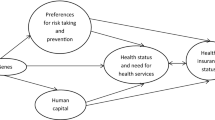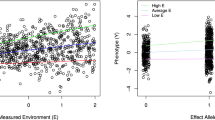Abstract
We examine the hypothesis that the heritability of smoking has varied over the course of recent history as a function of associated changes in the composition of the smoking and non-smoking populations. Classical twin-based heritability analysis has suggested that genetic basis of smoking has increased as the information about the harms of tobacco has become more prevalent—particularly after the issuance of the 1964 Surgeon General’s Report. In the present paper we deploy alternative methods to test this claim. We use data from the Health and Retirement Study to estimate cohort differences in the genetic influence on smoking using both genomic-relatedness-matrix restricted maximum likelihood and a modified DeFries–Fulker approach. We perform a similar exercise deploying a polygenic score for smoking using results generated by the Tobacco and Genetics consortium. The results support earlier claims that the genetic influence in smoking behavior has increased over time. Emphasizing historical periods and birth cohorts as environmental factors has benefits over existing GxE research. Our results provide additional support for the idea that anti-smoking policies of the 1980s may not be as effective because of the increasingly important role of genotype as a determinant of smoking status.





Similar content being viewed by others
Notes
Specifically we use the RAND Fat Files (Clair et al. 2011).
Clumping takes place in two steps. The first pass is done in fairly narrow windows (250 kb) for all SNPs (the p value significance thresholds for both index and secondary SNPs is set to 1) with a liberal LD threshold (r2 = 0.5). In a second pass, SNPs remaining after the first prune are again pruned in broader windows (5000 kb) but with a more conservative LD threshold (r2 = 0.2).
Available at http://spark.rstudio.com/ctgg/gctaPower/. The method is described in Visscher et al. (2014).
We used linear regression models instead of logistic regression models so as to ease interpretation of the relevant coefficients.
Estimates for PGS and its interaction with birth year and being female were 0.010 (p = 0.43), 0.001 (p = 0.06), and 0.026 (p = 0.01) respectively.
Estimates for PGS and its interaction with birth year and being female were 0.010 (p = 0.50), 0.001 (p = 0.05), and 0.026 (p = 0.01) respectively.
References
Belsky DW, Moffitt TE, Houts R, Bennett GG, Biddle AK, Blumenthal JA et al (2012) Polygenic risk, rapid childhood growth, and the development of obesity: evidence from a 4-decade longitudinal study. Arch Pediatr Adolesc Med 166(6):515–521
Belsky DW, Moffitt TE, Baker TB, Biddle AK, Evans JP, Harrington H et al (2013) Polygenic risk and the developmental progression to heavy, persistent smoking and nicotine dependence: evidence from a 4-decade longitudinal study. JAMA Psychiatry 70(5):534–542
Boardman JD, Daw J, Freese J (2013) Defining the environment in gene–environment research: lessons from social epidemiology. Am J Public Health. 103(S1):S64–S72.
Boardman JD, Fletcher JM (2015) To cause or not to cause? That is the question but identical twins might not have all of the answers. Soc Sci Med 127:198–200
Boardman JD, Saint Onge JM, Haberstick BC, Timberlake DS, Hewitt JK (2008) Do schools moderate the genetic determinants of smoking? Behav Genet 38(3):234–246
Boardman JD, Blalock CL, Pampel FC (2010) Trends in the genetic influences on smoking. J Health Soc Behav 51(1):108–123
Boardman JD, Blalock CL, Pampel FC, Hatemi PK, Heath AC, Eaves LJ (2011) Population composition, public policy, and the genetics of smoking. Demography 48(4):1517–1533
Boardman JD, Barnes LL, Wilson RS, Evans DA, de Leon CFM (2012) Social disorder, APOE-E4 genotype, and change in cognitive function among older adults living in Chicago. Soc Sci Med 74(10):1584–1590
Boardman JD, Domingue BW, Daw J (2015) What can genes tell us about the relationship between education and health? Soc Sci Med 127:171–180
Centers for Disease Control and Prevention (CDC) (2008) Smoking-attributable mortality, years of potential life lost, and productivity losses—United States, 2000–2004. MMWR Morb Mortal Wkly Rep 57(45):1226
Chang CC, Chow CC, Tellier LC, Vattikuti S, Purcell SM, Lee JJ (2014) Second-generation PLINK: rising to the challenge of larger and richer datasets. arXiv preprint arXiv:1410.4803
Clair PS, Bugliari D, Campbell N, Chien S, Hayden O, Hurd M, et al (2011) RAND HRS Data Documentation, Version L
Conley D, Cesarini D, Dawes C, Domingue B, Boardman JD (2015) Is the effect of parental education on offspring biased or moderated by genotype? Sociol Sci 2:82–105
Conley D, Siegal ML, Domingue BW, Harris KM, McQueen MB, Boardman JD (2014) Testing the key assumption of heritability estimates based on genome-wide genetic relatedness. J Hum Genet 59(6):342–345
Cutler DM, Glaeser EL (2009) Why do Europeans smoke more than Americans? Developments in the economics of aging. University of Chicago Press, Chicago, pp 255–282
DeFries JC, Fulker DW (1985) Multiple regression analysis of twin data. Behav Genet 15(5):467–473
Domingue BW, Fletcher J, Conley D, Boardman JD (2014) Genetic and educational assortative mating among US adults. Proc Natl Acad Sci 111(22):7996–8000
Dudbridge F (2013) Power and predictive accuracy of polygenic risk scores. PLoS Genet 9(3):e1003348
Escobedo LG, Peddicord JP (1996) Smoking prevalence in US birth cohorts: the influence of gender and education. Am J Public Health 86(2):231–236
Hamilton AS, Lessov-Schlaggar CN, Cockburn MG, Unger JB, Cozen W, Mack TM (2006) Gender differences in determinants of smoking initiation and persistence in California twins. Cancer Epidemiol Biomark Prev 15(6):1189–1197
Jackson JS, Knight KM, Rafferty JA (2010) Race and unhealthy behaviors: chronic stress, the HPA axis, and physical and mental health disparities over the life course. Am J Public Health 100(5):933–939
Li MD, Cheng R, Ma JZ, Swan GE (2003) A meta-analysis of estimated genetic and environmental effects on smoking behavior in male and female adult twins. Addiction 98(1):23–31
Link, B. G., & Phelan, J. (1995) Social conditions as fundamental causes of disease. J Health Soc Behav, 80–94
Lubke GH, Hottenga JJ, Walters R, Laurin C, De Geus EJ, Willemsen G et al (2012) Estimating the genetic variance of major depressive disorder due to all single nucleotide polymorphisms. Biol Psychiatry 72(8):707–709
Lumley T (2004) Analysis of complex survey samples. J Stat Softw 9(1):1–19
Perry BL, Pescosolido BA, Bucholz K, Edenberg H, Kramer J, Kuperman S et al (2013) Gender-specific gene–environment interaction in alcohol dependence: the impact of daily life events and GABRA2. Behav Genet 43(5):402–414
Plomin R, Haworth CM, Meaburn EL, Price TS, Davis OS (2013) Common DNA markers can account for more than half of the genetic influence on cognitive abilities. Psychol Sci 24(4):562–568
Purcell SM, Wray NR, Stone JL, Visscher PM, O’Donovan MC, Sullivan PF et al (2009) Common polygenic variation contributes to risk of schizophrenia and bipolar disorder. Nature 460(7256):748–752
Raine A (2002) Biosocial studies of antisocial and violent behavior in children and adults: a review. J Abnorm Child Psychol 30(4):311–326
Rehkopf DH (2014) Understanding the role of social and economic factors in GCTA heritability estimates. Presented at the 5th Annual IGSS Conference. Boulder, CO
Rietveld CA, Medland SE, Derringer J, Yang J, Esko T, Martin NW et al (2013) GWAS of 126,559 individuals identifies genetic variants associated with educational attainment. Science 340(6139):1467–1471
Speed D, Balding DJ (2015) Relatedness in the post-genomic era: is it still useful? Nat Rev Genet 16(1):33–44
Spitz MR, Amos CI, Dong Q, Lin J, Wu X (2008) The CHRNA5-A3 region on chromosome 15q24-25.1 is a risk factor both for nicotine dependence and for lung cancer. J Natl Cancer Inst 100(21):1552–1556
Tobacco and Genetics Consortium (2010) Genome-wide meta-analyses identify multiple loci associated with smoking behavior. Nat Genet 42(5):441–447
Vink JM, Boomsma DI (2011) Interplay between heritability of smoking and environmental conditions? A comparison of two birth cohorts. BMC Public Health 11(1):316
Visscher PM, Hemani G, Vinkhuyzen AA, Chen GB, Lee SH, Wray NR et al (2014) Statistical power to detect genetic (co) variance of complex traits using SNP data in unrelated samples. PLoS Genet 10(4):e1004269
Vrieze SI, McGue M, Miller MB, Hicks BM, Iacono WG (2013) Three mutually informative ways to understand the genetic relationships among behavioral disinhibition, alcohol use, drug use, nicotine use/dependence, and their co-occurrence: twin biometry, GCTA, and genome-wide scoring. Behav Genet 43(2):97–107
Welter D, MacArthur J, Morales J, Burdett T, Hall P, Junkins H et al (2014) The NHGRI GWAS Catalog, a curated resource of SNP-trait associations. Nucleic Acids Res 42(D1):D1001–D1006
Yang J, Benyamin B, McEvoy BP, Gordon S, Henders AK, Nyholt DR et al (2010) Common SNPs explain a large proportion of the heritability for human height. Nat Genet 42(7):565–569
Yang J, Lee SH, Goddard ME, Visscher PM (2011) GCTA: a tool for genome-wide complex trait analysis. Am J Hum Genet 88(1):76–82
Zajacova A, Burgard SA (2013) Healthier, wealthier, and wiser: a demonstration of compositional changes in aging cohorts due to selective mortality. Popul Res Policy Rev 32(3):311–324
Acknowledgments
This study was funded by NIH/NICHD R21 HD078031. Additional support came from R24 HD066613 which supports the CU Population Center. The Health and Retirement Study is sponsored by the National Institute on Aging (Grant Number NIA U01AG009740) and is conducted by the University of Michigan.
Conflict of Interest
The authors declare that they have no conflict of interest.
Human and Animal Rights and Informed Consent
All procedures performed in studies involving human participants were in accordance with the ethical standards of the institutional and/or national research committee and with the 1964 Helsinki declaration and its later amendments or comparable ethical standards. Informed consent was obtained from all individual participants included in the study.
Author information
Authors and Affiliations
Corresponding author
Appendix: GWDF validation
Appendix: GWDF validation
We conducted a simulation to demonstrate a correspondence in relatively simple settings between GREML heritability estimates and the b 3 estimate from Eq. 2. This simulation was based on a random sample of 5000 respondents from the full set of respondents and random sample of 200,000 SNPs. Based on this set of respondents and SNPs, we simulated three sets of phenotypes using GCTA. The sets differed only in the true heritability of the phenotypes. The true heritabilites for the three sets were 0.25, 0.5, and 0.75. For each level of heritability, we simulated ten phenotypes. Thus, we have 30 simulated phenotypes in total.
Genetic similarities from the full set of markers (not the reduced set of 200,000 used to simulate the phenotypes) were then used to compute GREML heritability estimates as well as the b 3 GWDF coefficient. Results are shown in Fig. 6. Figure 6a and b shows that the GREML heritability and GWDF coefficient estimates both increase along with the true heritability. The GREML heritability estimates and GWDF b3 estimates are correlated with the true heritabilities at 0.91 and 0.86 respectively. More importantly, the heritability estimates were strongly correlated (0.92) with the GWDF b3 estimates. The convergence of these results using two very different statistical techniques enhances our confidence in the validity of the GWDF approach and the empirical results that we present in the paper.
Rights and permissions
About this article
Cite this article
Domingue, B.W., Conley, D., Fletcher, J. et al. Cohort Effects in the Genetic Influence on Smoking. Behav Genet 46, 31–42 (2016). https://doi.org/10.1007/s10519-015-9731-9
Received:
Accepted:
Published:
Issue Date:
DOI: https://doi.org/10.1007/s10519-015-9731-9





